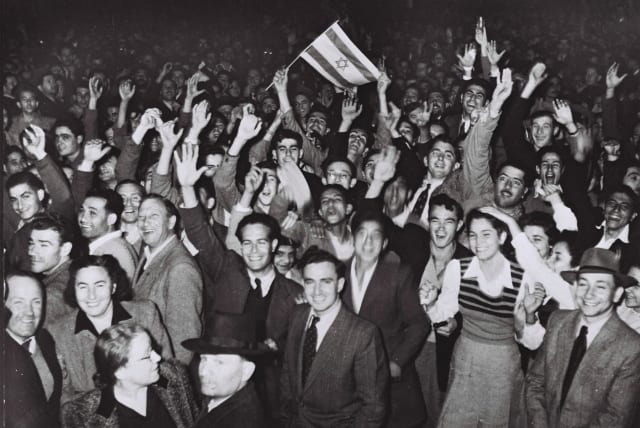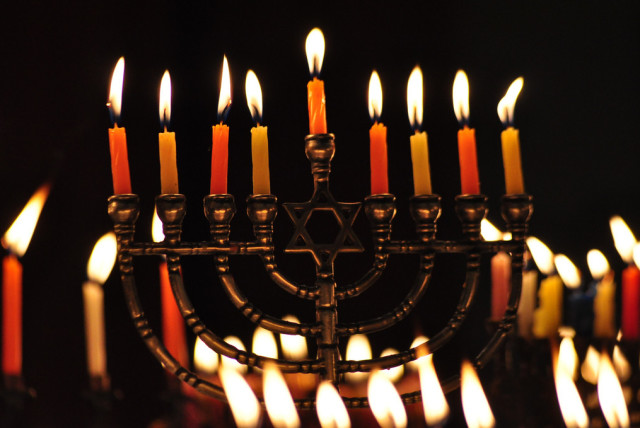Hanukkah vignettes: Scenes of the Festival of Lights in years past

As the sun disappeared that day, a large hanukkiah was rolled out. Eight giant candles and one more for the shamash.
November 29, 1947, was fast approaching. To be honest, I was not aware of what was supposed to be happening on that day. The excitement filled the air on the south side of Atlanta, Georgia, where 3,000 Jews lived. The exodus to the north side took place in stages. The largest synagogue, headed by Rabbi Harry Epstein since 1928, had not made plans to move. Shearith Israel was headed by Rav Tuvia Geffen and his associate rabbi, Hyman Friedman.
Everyone waited patiently on that Shabbat day as the votes were counted. The Partition Plan passed in the United Nations by 33 votes to 13, with 10 abstentions. Israel would become a state in May 1948. The Atlanta Jewish community waited two weeks to celebrate; we Young Judaeans were to be the hit of the show.
On December 13, the seventh candle of Hanukkah was lit, marking the celebration of our imminent Jewish state. We were halutzim (pioneers) and Maccabees. That moment was joyful for us and for our parents and grandparents – who had waited so long for a state.
We got into the spirit as we practiced our Israeli dance Mayim, the hora Artza Alinu, and singing “Hava Nagila.” We were fitted out for all-white clothes. On December 14, 1947, the celebration began at Ahavath Achim on Washington Street, which was so full of people that they spilled out into the street and had to be careful not to get too close to the streetcar tracks.
Cars were decorated with Magen David flags. People waved them. Then there was a convoy to the Jewish Progressive Club, which was already surrounded by the large crowds of Jews and Christians. The dream of a Jewish state reborn had come true. We danced the Israeli dances to great cheers from the overflowing crowds.
As the sun disappeared that day, a large hanukkiah was rolled out. Eight giant candles and one more for the shamash. The members of DSI (Devoted Sons of Israel) and senior Young Judaeans sang the blessings they had practiced, with real fervor.
Hanukkah in Oklahoma
Fort Sill, Oklahoma, was my base from 1965-1967 – my tour of duty during the Vietnam War. Fort Sill has a long history. It was built in the 1850s during the fighting against the Native Americans, which sadly drove them away from their ancestral homes. By the time my wife and I arrived in 1965, the preparation of American soldiers for the artillery branch to be sent to Vietnam was in full swing. Of the 80,000 men who trained for eight weeks before being shipped out, many never returned.
Most exciting for me as chaplain and for the Jewish troops (at one point as many as 800) was the wonderful hanukkiah with Judah Maccabee painted on one side and Antiochus the Hellenizer on the other. It had been built in the Fort Sill carpentry shop under the guidance of the former chaplain. It had a raised tube in the middle for the shamash, and electric bulbs in place of candles. It was plugged in outside my little home office.
The Jewish troops out in the field, training and firing the big guns over and over, had no hanukkiah and felt left out. My assistant and I appealed to the chief chaplain, the Catholic colonel James McMahon, for permission to take the big hanukkiah out to the firing area for one of the eight nights. Of course, we planned to use giant candles.
We arrived in the middle of the enormous artillery training field with the hanukkiah, and about 30 Jewish soldiers appeared. Several lit the candles, we sang “Maoz Tzur” (not very well), and then we burst into “I Had a Little Dreidel.” Everyone received a bag with a plastic dreidel, chocolate candy coins, and some other treats.
As the hanukkiah was lit in the field where the famous Apache chief Geronimo is buried and where shooting continued to be heard day and night, I wondered what he would have made of it.
A hanukkiah comes home
I have been friends with retired policeman Aryeh Lewis since 1963. Fortunately, we both made aliyah with our families, and that has made all the difference. He shared this wondrous tale with me many years ago.
Avrumel Greenbaum was a Holocaust survivor. After losing his entire family, he entered the United States as a displaced person (DP), went to live in a small town in Alabama, and changed his name to Aaron Green. He was fortunate to meet and marry a Jewish woman; however, instead of celebrating his son Jeffrey’s bar mitzvah, he simply took him to the local mall and told him to choose whatever he wanted.
When they arrived at the mall, Aaron took his son to store after store until they finally found an electronics store. Rather than look at all the glittering items, Jeffrey’s eyes wandered across the mall to an antique shop. He pushed his father in its direction and pointed toward a wooden hanukkiah, indicating that he had found something he truly wanted.
Aaron approached the store owner and asked to buy the hanukkiah in the window. “Not for sale,” the shop owner said firmly. When the boy heard that, he started to cry. His father asked again, and the shop owner again refused.
“I have discovered the history of this hanukkiah. Someone fashioned it during the war,” the owner said. “He worked for months collecting the wood to make this Hanukkah treasure. I know it will be a collector’s item, so I cannot sell it.”
Aaron and his son returned to the store again and again, each time offering more and more money for the hanukkiah. At a certain point, the owner had to admit that the amount of money offered was a sum that he really needed.
So the hanukkiah was wrapped up, and Aaron and his son took it home.
Jeffrey was so excited. He took the hanukkiah to his room, happy with his present, and would constantly pick it up and hold it. One day the hanukkiah fell from the boy’s hands and broke into many pieces. His parents heard the noise and rushed up to the room, only to find the hanukkiah shattered. At first, Aaron was very angry, but then he told his son, “We’ll work on the hanukkiah and try to put it back together.”
As the father was reconstructing the hanukkiah, he found a piece of paper that had been stuck inside. As he began to read the Yiddish words, he fainted. Once revived, he read the words aloud.
“To whomever finds this hanukkiah, I want you to know – I constructed it not knowing if I would ever have the opportunity to light it... Who knows if I can live and kindle its lights? Probably not. To whomever finds this hanukkiah, light it and remember all those who could never make it glow.”
Aaron Green, with tears in his eyes, said that the letter had been written by his father.
Jerusalem Post Store
`; document.getElementById("linkPremium").innerHTML = cont; var divWithLink = document.getElementById("premium-link"); if (divWithLink !== null && divWithLink !== 'undefined') { divWithLink.style.border = "solid 1px #cb0f3e"; divWithLink.style.textAlign = "center"; divWithLink.style.marginBottom = "15px"; divWithLink.style.marginTop = "15px"; divWithLink.style.width = "100%"; divWithLink.style.backgroundColor = "#122952"; divWithLink.style.color = "#ffffff"; divWithLink.style.lineHeight = "1.5"; } } (function (v, i) { });

